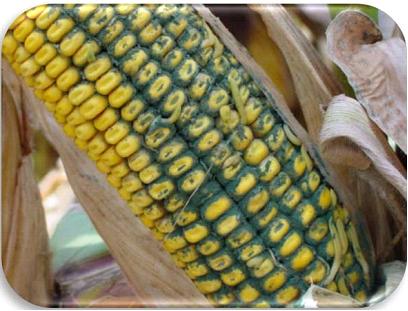
Source: DuPont Pioneer
(https://www.pioneer.com/home/site/mobile/harvest/corn/ear-rots-uncommon/ )
Symptoms:
Initially a white mold growth that later turns green and powdery on and between kernels and husk, often involving whole ear. Often associated with damage from birds and other mechanical damage. Trichoderma ear rot damage usually spotty throughout a field. Trichoderma ear rot is not associated with mycotoxins.
Cause:
Fungus -Trichoderma viride. Often associated with other leaf or ear diseases, premature plant death due to frost and stalk rot. More common when rainfall is above average the month preceding harvest.
-
Typical symptoms include a dark green fungal growth on and between husks and kernels, often involving the entire ear
-
Fungal disease of ears usually associated with injury to the developing ear, including damage from bird or insect feeding or other mechanical injury
-
For this reason, damage is not found on every ear, but rather, is usually more scattered within a field
-
Management:
Plant a hybrid with ear rot resistance; avoid planting corn on corn, especially under conservation tillage, and reduce stress on the plants with adequate fertilization and good insect pest management.
References:
Lipps, P. E., A. E. Dorrance, and Dennis Mills. 2004. Corn Disease Management in Ohio Bulletin 802.
Robertson, A. 2004. Corn Ear Rots. Iowa State University IPM.IC-492(21) [October 4, 2004] Available at https://lib.dr.iastate.edu/cgi/viewcontent.cgi?referer=https://www.google.com/&httpsredir=1&article=2505&context=cropnews [URL verified 3/28/2019].